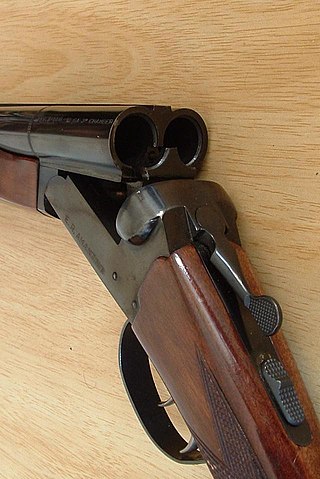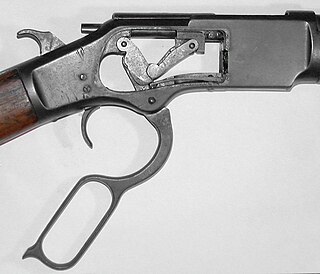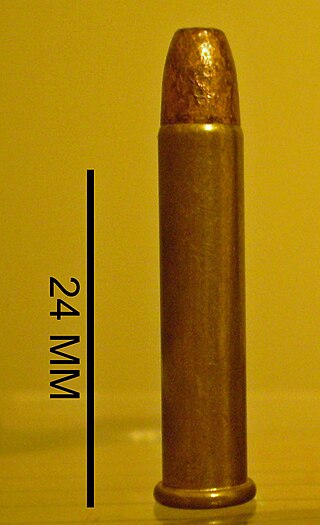
In firearms terminology, an action is the functional mechanism of a breech-loading firearm that handles the ammunition cartridges, or the method by which that mechanism works. Actions are technically not present on muzzleloaders, as all those are single-shot firearms with a closed off breech with the powder and projectile manually loaded from the muzzle. Instead, the muzzleloader ignition mechanism is referred to as the lock.
Winchester rifle is a comprehensive term describing a series of lever action repeating rifles manufactured by the Winchester Repeating Arms Company. Developed from the 1860 Henry rifle, Winchester rifles were among the earliest repeaters. The Model 1873 was particularly successful, being marketed by the manufacturer as "The Gun That Won the West".

A lever action is a type of action for repeating firearms that uses a manually operated cocking handle located around the trigger guard area that pivots forward to move the bolt via internal linkages, which will feed and extract cartridges into and out of the chamber, and cock the firing pin mechanism. This contrasts to other type of repeating actions such as the bolt-action, pump-action, semi-automatic, fully automatic, and/or burst mode actions. A firearm using this operating mechanism is colloquially referred to as a levergun.
Pump action is a type of manual firearm action that is operated by moving a sliding handguard on the gun's forestock. When shooting, the sliding forend is pulled rearward to eject any expended cartridge and typically to cock the hammer or striker, and then pushed forward to load a new cartridge into the chamber. Most pump-action firearms use an integral tubular magazine, although some do use detachable box magazines. Pump-action firearms are typically associated with shotguns, although it has been used in rifles, grenade launchers, as well as other types of firearms. A firearm using this operating mechanism is colloquially referred to as a pumpgun.

.22 Short is a variety of .22 caliber (5.6 mm) rimfire ammunition. Developed in 1857 for the first Smith & Wesson revolver, the .22 rimfire was the first American metallic cartridge. The original loading was a 29 or 30 gr bullet and 4 gr of black powder. The original .22 rimfire cartridge was renamed .22 Short with the introduction of the .22 Long in 1871.

The .22 Winchester Magnum Rimfire, also known as the .22 WMR, .22 Magnum, .22 WMRF, .22 MRF, or .22 Mag, is a rimfire cartridge. Originally loaded with a bullet weight of 40 grains (2.6 g) delivering velocities in the 2,000 feet per second (610 m/s) range from a rifle barrel, .22 WMR is now loaded with bullet weights ranging from 50 grains (3.2 g) at 1,530 feet per second (470 m/s) to 30 grains (1.9 g) at 2,200 feet per second (670 m/s).
The Ruger 10/22 is a series of semi-automatic rifles produced by American firearm manufacturer Sturm, Ruger & Co., chambered for the .22 Long Rifle rimfire cartridge. It uses a patented 10-round rotary magazine, though higher capacity box magazines are also available. The standard carbine version of the Ruger 10/22 has been in production continuously since 1964, making it one of the most successful rimfire rifle designs in history, with numerous third party manufacturers making parts and accessories for upgrading and customization. The 10/22's aftermarket is so prolific that a complete 10/22 can be built without using any Ruger-made components.

Sako Ltd is a Finnish firearm and ammunition manufacturer located in Riihimäki, Tavastia Proper in southern Finland. It also has owned the Tikka brand of bolt-action rifles since 1983, and is now owned by the Italian firearm holding company Beretta Holding. The name Sako comes from the company's former name Suojeluskuntain Ase- ja Konepaja Oy.

The Marlin 39A is the oldest and longest continuously produced shoulder firearm in the world. The current variation gold trigger lever-action .22 Caliber Golden 39A is produced by the Marlin Firearms Co. of New Haven, Connecticut. The Golden 39A was last constructed in Remington’s Marlin factory in Ilion, NY. Production ended with the bankruptcy and closing of the Remington Marlin factory closing and sale to Ruger in September, 2020.
Marlin Firearms is an American manufacturer of semi-automatic, lever-action and bolt-action rifles. In the past the company made shotguns, derringers, and revolvers. Marlin owned the firearm manufacturer H&R Firearms. In 2007, Remington Arms, part of the Remington Outdoor Company, acquired Marlin Firearms. Remington produced Marlin-brand firearms at its Kentucky and New York manufacturing facilities. In 2020, Sturm, Ruger & Co. bought the Marlin business from bankrupt Remington Outdoor Company.

.17 Hornady Magnum Rimfire, commonly known as the .17 HMR, is a rimfire rifle cartridge developed by Hornady in 2002. It was developed by necking down a .22 Winchester Magnum Rimfire case to take a .17 caliber (4.5 mm) projectile. Commonly loaded with a 17 grain projectile, it can deliver muzzle velocities in excess of 775 m/s (2,650 ft/s).
The Henry repeating rifle is a lever-action tubular magazine rifle famed both for its use at the Battle of the Little Bighorn and being the basis for the iconic Winchester rifle of the American Wild West.

Harrington & Richardson is an American brand of firearms and a subsidiary of JJE Capital Holdings. H&R ceased independent production February 27, 2015.
The Marlin Model 60, also known as the Marlin Glenfield Model 60, is a semi-automatic rifle that fires the .22 LR rimfire cartridge. Produced by Remington Arms in Huntsville, Alabama formerly in Mayfield, Kentucky, formerly by Marlin Firearms Company of North Haven, Connecticut, it was in continuous production from 1960 to 2020 and the company says it is the most popular rifle of its kind in the world. Major features include a micro-groove barrel, a cross-bolt safety, hardwood stock with Monte Carlo comb, and brass or blued steel inner magazine tube. The Marlin Model 795 is a very similar rifle and based on the Marlin Model 60, changed only to accept a detachable box magazine.
The Marlin Model 336 is a lever-action rifle and carbine made by Marlin Firearms. Since its introduction in 1948, it has been offered in a number of different calibers and barrel lengths, but is commonly chambered in .30-30 Winchester or .35 Remington, using a 20- or 24-inch barrel. Currently, the model with a 24-inch barrel is only available in .30-30 Winchester. The Model 336 is now back in production as of March 27, 2023.
From 1908 until 1962, Sears, Roebuck & Company sold a wide variety of sporting goods and recreational equipment, including bicycles, golf clubs, rifles, shotguns, and revolvers under the brand name "J. C. Higgins." These products were well made and were popular with the company's historical core of rural and working-class consumers.
The Winchester Model 1894 rifle is a lever-action repeating rifle that became one of the most famous and popular hunting rifles of all time. It was designed by John Browning in 1894 and originally chambered to fire two metallic black powder cartridges, the .32-40 Winchester and .38-55 Winchester. It was the first rifle to chamber the smokeless powder round, the .30 WCF in 1895. In 1901, Winchester created the new .32 Winchester Special caliber with production of rifles starting in 1902.

The Browning BLR is a lever-action rifle manufactured for Browning Arms Company by Miroku Firearms in Japan. It comes in many different variations and is chambered in numerous calibers from small and fast to the large Magnum rounds, and the large bore .450 Marlin.

The Marlin Model 1894 is a lever-action repeating rifle introduced in 1894 by the Marlin Firearms Company of North Haven, Connecticut. At its introduction the rifle came with a 24-inch barrel and was chambered for a variety of rounds such as .25-20 Winchester, .32-20 Winchester, .38-40, and .44-40. Variants in other chamberings remain in production today.
The Marlin Model 780 is a .22 bolt-action rifle produced by Marlin Firearms Company of North Haven, Connecticut. Major features include micro-groove barrel, a 2-position safety lever, walnut stock, and 7-round box magazine. Production of the model 780 ended in 1988, and it was replaced by the Marlin 880 in 1989.









